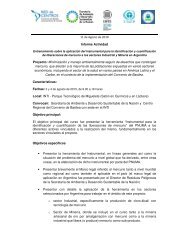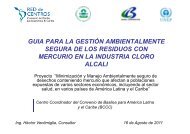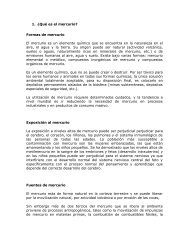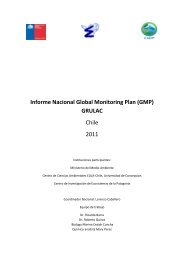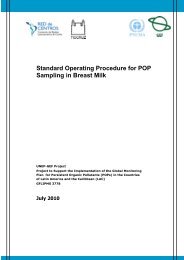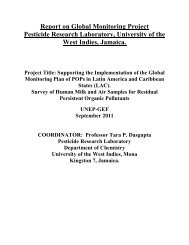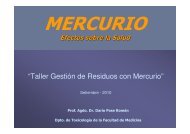GuÃa ESM de residuos con mercurio de plantas Cloro-Alcali - Centro ...
GuÃa ESM de residuos con mercurio de plantas Cloro-Alcali - Centro ...
GuÃa ESM de residuos con mercurio de plantas Cloro-Alcali - Centro ...
Create successful ePaper yourself
Turn your PDF publications into a flip-book with our unique Google optimized e-Paper software.
2 LIBERACIONES AL AMBIENTE<br />
En el siguiente esquema se indican las diferentes corrientes <strong>de</strong> liberaciones al ambiente <strong>de</strong> un proceso típico <strong>de</strong><br />
fabricación <strong>de</strong> cloro, soda e hidrógeno en celda <strong>de</strong> <strong>mercurio</strong>.<br />
Residuos Sólidos<br />
Efluentes<br />
Emisiones gaseosas<br />
SAL<br />
SATURACIÓN DE<br />
LA SALMUERA<br />
PRECIPITACIÓN<br />
Químicos<br />
FILTRACIÓN<br />
ELECTROLISIS<br />
COLUMNA DE<br />
LAVADO<br />
TRATAMIENTO DE<br />
RESIDUOS<br />
AMALGAMA<br />
MERCURIO<br />
ENFRIAMIENTO<br />
DESCOMPONEDOR<br />
SECADO<br />
REMOCIÓN DE<br />
MERCURIO<br />
ENFRIAMIENTO<br />
COMPRESIÓN<br />
ENFRIAMIENTO<br />
REMOCIÓN DE<br />
MERCURIO<br />
LICUEFACCIÓN<br />
ALMACENAMIENTO<br />
EVAPORACIÓN<br />
SODA CÁUSTICA<br />
HIDRÓGENO<br />
CLORO<br />
Fuente: Euro Chlor, 2006,b<br />
Con el fin <strong>de</strong> caracterizar <strong>con</strong>venientemente a los diferentes <strong>residuos</strong>, se los clasifica <strong>de</strong> acuerdo a su estado<br />
físico en: emisiones atmosféricas, efluentes líquidos y <strong>residuos</strong> sólidos.<br />
2.1 EMISIONES AL AIRE<br />
Las corrientes gaseosas más significativas en cuanto a su riesgo ambiental por presencia <strong>de</strong> <strong>mercurio</strong> son:<br />
2.1.1 Ventilación <strong>de</strong>l cuarto <strong>de</strong> celdas.<br />
La ventilación <strong>de</strong>l cuarto <strong>de</strong> celdas es una <strong>de</strong> las más importantes fuentes <strong>de</strong> emisiones <strong>de</strong> <strong>mercurio</strong> al aire.<br />
Supera en casi diez veces a los escapes <strong>de</strong>l proceso. Dicho recinto es ventilado por circulación natural <strong>de</strong> aire.<br />
El <strong>mercurio</strong> en la celdas está a una temperatura <strong>de</strong> aproximadamente 80°C y a efectos <strong>de</strong> lograr el enfriamiento<br />
necesario se estima una tasa <strong>de</strong> recambio <strong>de</strong> aire <strong>de</strong> entre 10 y 25 veces por hora. Los valores van <strong>de</strong> 20.000 a<br />
100.000 Nm3/tonelada <strong>de</strong> capacidad <strong>de</strong> cloro.<br />
Un sistema <strong>de</strong> ventilación correctamente diseñado y operado asegura <strong>con</strong>centraciones <strong>de</strong> <strong>mercurio</strong> en el rango<br />
<strong>de</strong> 2 – 20 µg/Nm3. Plantas europeas que aplican buenas prácticas operativas reportan valores <strong>de</strong> 0.17 a 0.21<br />
g/tonelada <strong>de</strong> capacidad <strong>de</strong> cloro.





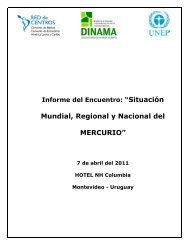
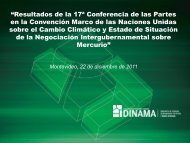

![COP_aire [Compatibility Mode] - Centro Coordinador de Basilea ...](https://img.yumpu.com/44106171/1/190x134/cop-aire-compatibility-mode-centro-coordinador-de-basilea-.jpg?quality=85)


